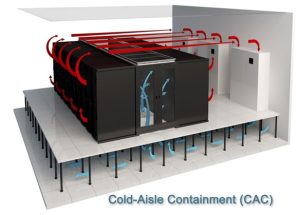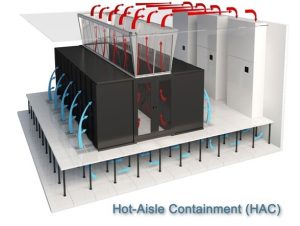Are you looking at your server room efficiency? Here we discuss hot and cold aisle separations as an option for your server room cooling. We’ll also be taking a closer look at what possible gains could be made by using this option.
For more information about how we can help you with server room efficiency get in contact with us here.
Traditional Practice
Many server rooms are cooled by a number of CRAC (computer room air conditioning) systems designed to maintain an overall room temperature of typically 20-22°C. As IT equipment technology evolves, and server rooms are re-configured to suit upgraded IT systems, there are ways to improve the cooling systems which can greatly improve energy efficiency and save running costs.
What is Hot/ Cold Aisle separation?
This is a method of ensuring that all of the supply air from the CRAC units is delivered to the point where it is needed and that once the air has done its cooling job, it returns directly back to the CRAC unit without doing any more unnecessary work.
How are the aisles separated?
The attached examples show how either the cold aisle or the hot aisle could be physically separated. These are examples of down flow systems supplying air into a raised floor, but the principle could be applied equally for up flow systems in server rooms without a raised floor.


How does this improve efficiency?
There are two main reasons why this helps reduce power consumption:-
- Higher return air temperatures to the CRAC units means that the refrigeration systems become more efficient and the compressors absorb less power.
- A more efficient air distribution means that the heat from the servers is removed on only one sweep of cooled air, rather than by free-blow turbulent air.
What effect does this have on my running costs?
The attached typical pay-back calculation demonstrates how separation of the hot and/ or cold aisle can translate into reduced power consumption and subsequent cost savings.
Can this work for existing rooms as well as new rooms?
All server rooms, existing or new, would benefit from separation of the hot and/ or cold aisles. The extent of the benefit would depend on the degree of difficulty in creating the separation, which would, in turn, affect the pay-back period.

